How to install a TV on a wall
Modern TVs are very thin, so they can not be placed on bulky bedside tables. The most common option is to hang the TV on the wall. This solution has a lot of advantages, which is why it has become very popular.
The content of the article
Pros and cons of wall mounting
Advances in technology have given us televisions of very small thickness, but with excellent picture quality - plasma (RPTV), liquid crystal (LCD) and optical light-emitting diodes (OLED). This made it possible not to put them on cabinets or other furniture, but to hang them directly on the wall. The pros are obvious. The first is space saving. The second - you can hang the TV in the entrance area and it will not interfere with the movement, which cannot be said even about a small bedside table. The third plus is that with wall mounting there is less chance of knocking or otherwise damaging expensive equipment.
There are also disadvantages. The first - a more or less solid screen will have to be installed together. Weight of 30 kilograms or more, it is difficult to keep "in one hand". Second, you need to choose a high-quality TV mount on the wall. The mass is considerable and will need to be kept constantly, so the safety margin should be solid. The third - not all walls can be hung: the bearing capacity of drywall, aerated or foam concrete is often not enough. Unless during construction, you fixed mortgages in the frame that can withstand heavy loads. There are special TV brackets for such cases, but they cost more, and not all masses have them.
Where and at what height is it better to hang the TV on the wall
First of all, you need to decide on the location as well as the height of the screen on the wall. In the living room, the TV is usually placed in the recreation area - opposite the sofa and armchairs. In this case, the height is determined depending on the design of the furniture. You need to look comfortably, and for this, the middle part of the screen should be approximately at human eye level. So the height of the TV installation on the wall is determined experimentally, but on average it is 100-120 cm.
In the bedroom, the approach is the same, but you will mainly watch while lying down, so the mounting height of the TV is slightly less - about a meter.
In the kitchen, the approach is completely different. There is rarely time to pay attention to the picture, and there is not much space. Therefore, the TV in the kitchen is usually hung closer to the ceiling and the brackets are sometimes chosen from the ceiling type, rather than the wall type. This approach has one more advantage - highly installed equipment is safer.
As for the placement of the screen relative to the audience, the optimal distance is determined for plasma screens - this is 3-4 diagonals of the TV. With this arrangement, it will be convenient to watch (with normal vision). For all other types of screen, the distance is selected which is convenient, but the minimum distances are given in the table. It is better not to place furniture closer - it will be completely uncomfortable.
| Screen size in inches | Screen size in centimeters | Minimum distance to screen |
|---|---|---|
| 73' | 185 cm | 3.71 m |
| 65' | 165 cm | 3.3 m |
| 57' | 145 cm | 2.9 m |
| 50' | 127 cm | 2.54 m |
| 46' | 117 cm | 2.34 m |
| 42' | 107 cm | 2.13 m |
| 37' | 81.3 cm | 1.88 m |
When choosing the location of the TV on the wall, it should be borne in mind that for normal operation it must be well ventilated. Therefore, installation in a niche is very undesirable, although this is the latest trend in design - to make a niche out of drywall, and hang a TV in it. In extreme cases, such a mounting method is acceptable, but the dimensions of the niche should be much larger than the size of the TV - in order for the air to more or less circulate and cool the rear surface. But even in this case, the TV can quickly fail - overheating has a bad effect on performance.
Choice of brackets
To hang the TV on the wall, you need to choose brackets. First, look at the back of the device. There should be four holes for mounting the mounting plates. You need to measure the distances between them and the post when choosing a bracket to be guided by them.
There are brackets in which all four mounts are fixed, there are more universal brackets in which the horizontal distance changes.
Next, select the type of TV bracket:
- For fixed installation. They are two plates - one is mounted on the wall, the second on the back of the TV. During installation, the screen is simply hung on a plate that is hung on the wall. The fasteners take up little space, the monitor is located almost against the wall. A very small gap remains - 10-20 mm.
- With rotation in the horizontal plane, that is, the screen can be rotated left and right. This type of TV bracket protrudes from the wall for a certain distance, most often - a small one - a few centimeters. Otherwise, you will not provide a turn.
- With vertical rotation - you can slightly tilt the screen up / down. This type of bracket is most commonly used in kitchens. After all, there TVs are mounted high on the wall, and in order to be comfortable to watch, you need to tilt the screen a little.
- Rotatable in both planes. This is a good option, but there are a lot of such brackets.
The most common TV mounts are conventional. There are few cases where the ability to rotate the screen is required, mainly only in the kitchen. Therefore, it makes no sense to overpay for unnecessary options.
In addition, the bracket for the TV must be selected by weight and diagonal. This is one of the most important criteria that the safety of your equipment depends on.
Installation procedure
After you have chosen a place to install the TV and a bracket, mark the place for mounting on the wall. Before further work, check that there are no communications in the wall - there were no wiring, pipes, etc. This can be done using detector wiring... If everything is fine and no wires were found, we attach the bracket plate to the wall, make marks for each hole. At the same time, make sure that the marks are strictly horizontal. The slightest misalignment may cause the screen to fall.
According to the marks made, holes are drilled into which the dowels are inserted, then the mounting plate is installed and bolted.
We proceed to fastening the counter plate. A counter plate is installed on the back of the TV. It attaches to the holes on the rear panel. Fasteners are usually installed in them, we unscrew it and use it during installation. If there is no fastener, we select it according to the size of the holes.
After fixing the counter panel, we hang the TV on the wall. As already mentioned, it is more convenient to do this together - you need to get out of the groove. To make this easier, practice without a screen before editing.
Only by hanging the TV on the wall can you deal with the wires. You can connect to a standard outlet, but the wires should not be taut, even when turning to the maximum angle. It is important. That's all, now you know how to hang a TV on the wall with your own hands.
Homemade TV brackets
In order to hang a TV on the wall, it is not necessary to buy special brackets, the simplest of which cost quite decent money. It is quite possible to make a mount with your own hands and for ridiculous money. For example, in a stationary installation - just on a wall, without the ability to change the angle of inclination - you can do with mounting angles with holes and bolts of a suitable size with washers and nuts. All this is in any hardware store. You will need six pieces of corners - two for the wall and four for the screen, as well as two bolts. We attach the corners on the back of the TV in the required places.
We measure the distance between the upper ones and attach two to the wall. On those on the wall, fasten the bolts with the rod upwards, placing a washer under the nut. Then we put the TV on these pins. At their expense, it is held, and the lower plates on the screen simply rest against the wall, fixing it in a certain position.
Good idea and very budget friendly. You can add that you can fix the bolts on the screen, only with the pins down. The effect will be the same.
The second option is to use sliding supports to secure the rafters. They are detachable, as in the photo below. The plate bent in the form of the letter "L" must be straightened, drilled in the upper part of the hole for the fasteners, then attached to the back of the TV.
The counter plates are attached to the wall. You can - on a bar. Then the screen will be tilted down some angle (like the author of this method). And if the bar is still made with a bevel in one direction, then there will also be a turn in the right direction.
As you guessed, the screen is simply hung with hooks on the grooves. Everything is simple and extremely economical. The disadvantage of this method: sometimes the holes for the fasteners are located so that these plates cannot be attached to them. In this case, you have to make new holes in the housing cover (after removing it first).

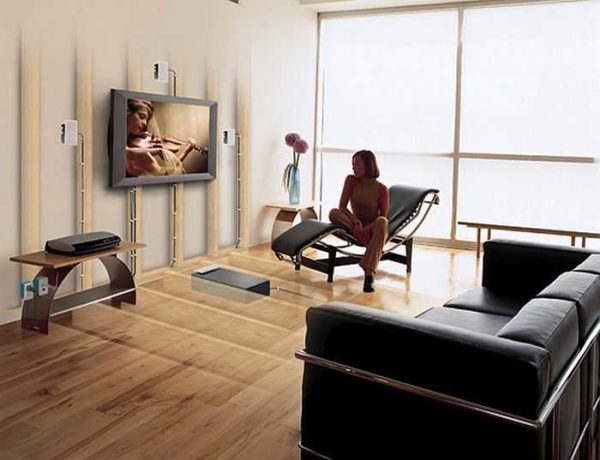
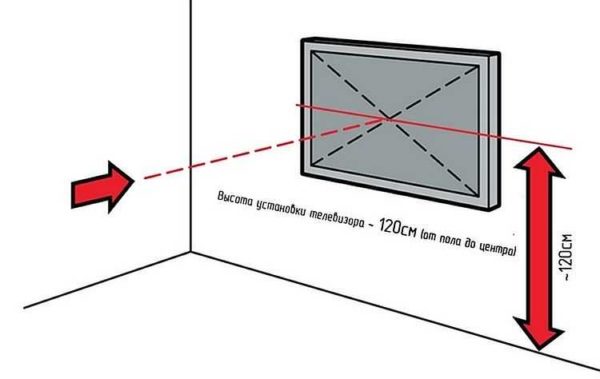
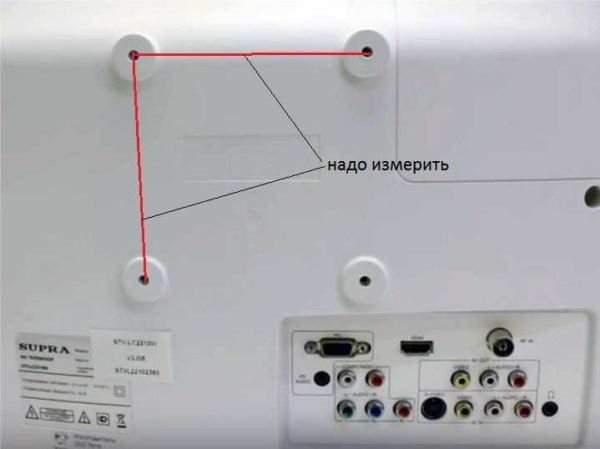
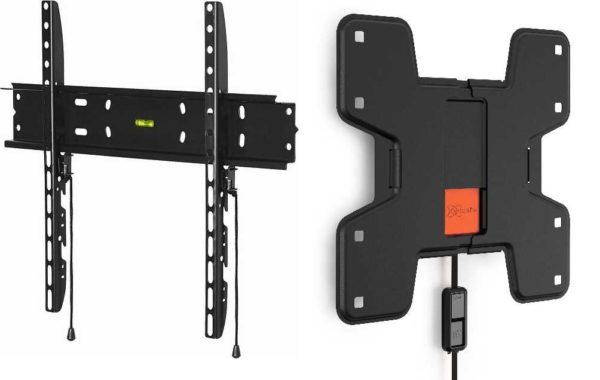
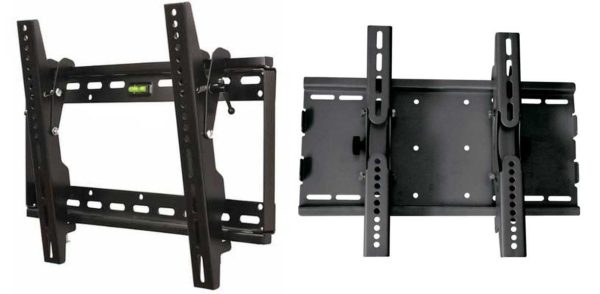
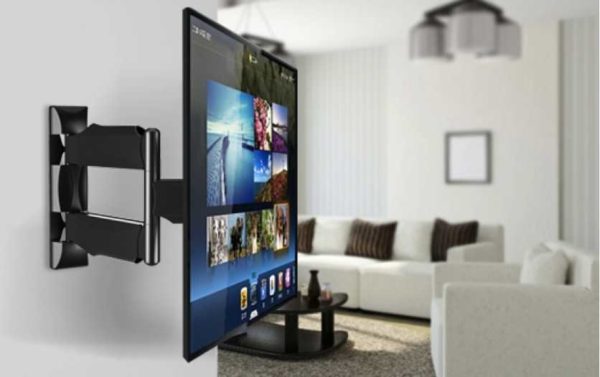
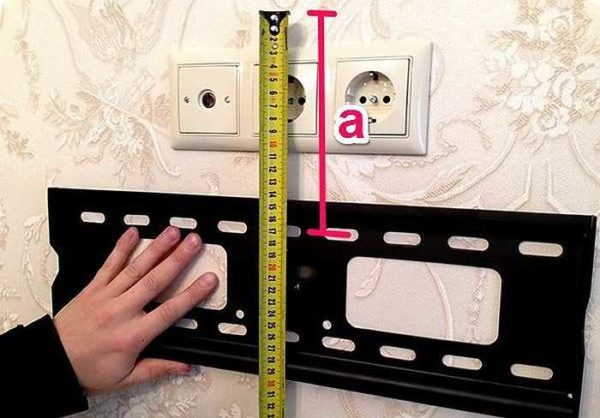
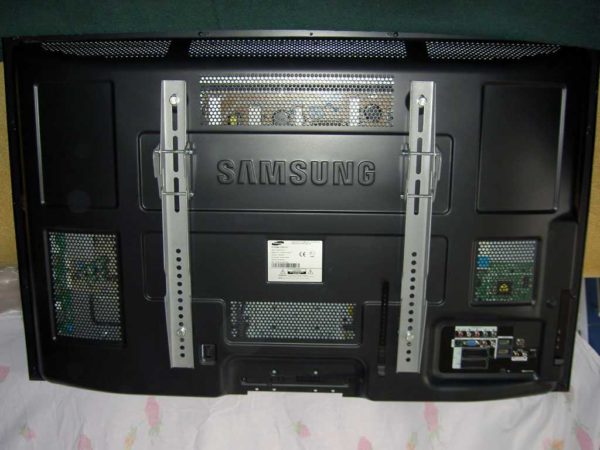
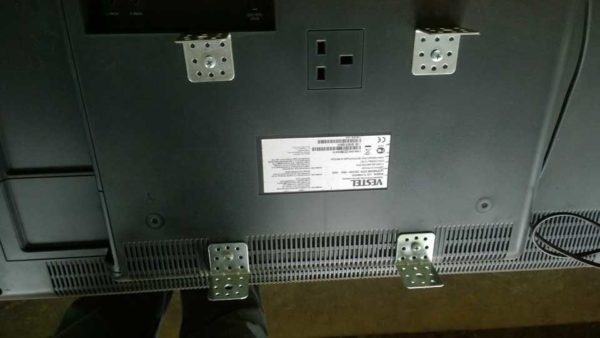
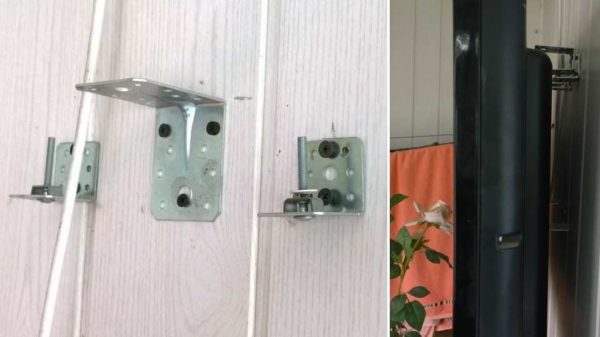
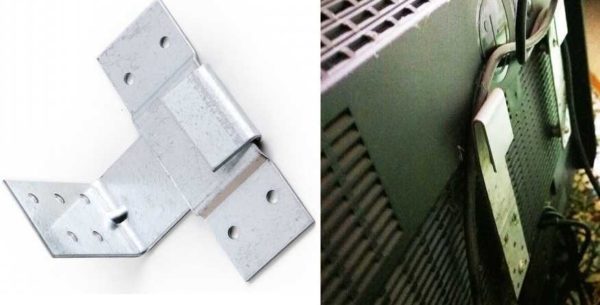
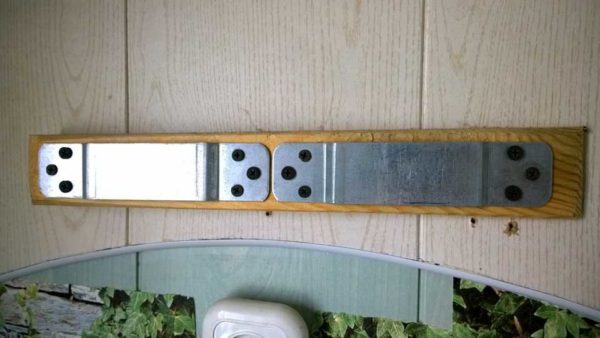


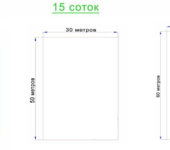







I also think that there is no point in overpaying. For most medium-sized TVs 200 × 200, a domestic bracket is suitable